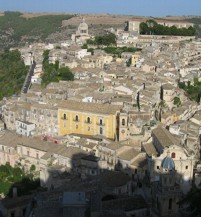Home - In and around
RAGUSA HERITAGE
Monuments and places of interesseRagusa has been catalogued in 2002 a world heritage site, is one of the most important art cities in Italy, thanks to a variety of artistic and archaeological treasures, legacy of its ancient history.
The reconstruction of the city after the earthquake of 1693 had famous actors such as V, Palma, John Vermexio, Sebastiano Ittar, Vincenzo Sinatra and above all the famous Rosario Gagliardi. These, with the help of a bevy of local sculptors and master builders, has helped create a unique phenomenon: the baroque of Val di Noto.
It is adorned by the local stone volute, of voids and solids, columns and capitals, statues and architectural compositions, of which probably the Duomo di San Giorgio is the ultimate expression. Since the end of the sixteenth century to Ragusa circulated books such as Sebastiano Serlio's architectural treatise, i Quattro libri dell'Architettura by Palladio, the works of Domenico Fontana and other texts of famous architects.
Il barocco Ragusa is a reworking of works or drawings, custom templates and masters. Made with local stone, warm Golden, effects, related only to the Baroque. Most of the artistic heritage, with the exception of the Cathedral of St. John the Baptist and some 18th century building, is located in the old quarter of Ibla.
The only area of Ragusa Ibla contains over fifty churches, most are in the late Baroque style. Even the historical buildings are numerous. Of all structures built between late Antiquity and the end of the 17th century there are only fragments:
Countless were the works brought to an end in the 1930s in a very short time, to coordinate projects was called the architect Ugo Tarchi della reale accademia di Brera, which notably oversaw the study and construction of urban square Empire, with the majestic Palazzo del Fascio characterized the high central tower, designed by architect Ernesto Lapadula.
On the same square also began the building of the provincial Council of corporations, today seat of the Chamber of Commerce, the architect Farrel.
Beside the Cathedral is the War Memorial, bronze sculptor Sindoni, on marble plinth, inaugurated on 12 May 1924.
wiki source
The reconstruction of the city after the earthquake of 1693 had famous actors such as V, Palma, John Vermexio, Sebastiano Ittar, Vincenzo Sinatra and above all the famous Rosario Gagliardi. These, with the help of a bevy of local sculptors and master builders, has helped create a unique phenomenon: the baroque of Val di Noto.
It is adorned by the local stone volute, of voids and solids, columns and capitals, statues and architectural compositions, of which probably the Duomo di San Giorgio is the ultimate expression. Since the end of the sixteenth century to Ragusa circulated books such as Sebastiano Serlio's architectural treatise, i Quattro libri dell'Architettura by Palladio, the works of Domenico Fontana and other texts of famous architects.
Il barocco Ragusa is a reworking of works or drawings, custom templates and masters. Made with local stone, warm Golden, effects, related only to the Baroque. Most of the artistic heritage, with the exception of the Cathedral of St. John the Baptist and some 18th century building, is located in the old quarter of Ibla.
The only area of Ragusa Ibla contains over fifty churches, most are in the late Baroque style. Even the historical buildings are numerous. Of all structures built between late Antiquity and the end of the 17th century there are only fragments:
- a short section of the city walls, near the Church of S.S. found,
- the portal of the Swabian period and
- the Bell Tower in the Church of San Francesco to the Immaculate,
- the portal of the Church of San Giorgio,
- the only remnant of the ancient temple;
- the port Walter, one of the doors opening in the walls of the Byzantine era;
- a small Gothic portal masoned outside the Church of Sant'Antonino;
- the chapels attached to one of the naves of the Church of Santa Maria delle Scale;
- the sculptures inside the sacristy of the Duomo di San Giorgio, dated 1570 attributed to Antonio Gagini, son of Antonello Gagini, died 1536;
- some fragments of the tombstone of count Bernardo Cabrera.
Countless were the works brought to an end in the 1930s in a very short time, to coordinate projects was called the architect Ugo Tarchi della reale accademia di Brera, which notably oversaw the study and construction of urban square Empire, with the majestic Palazzo del Fascio characterized the high central tower, designed by architect Ernesto Lapadula.
On the same square also began the building of the provincial Council of corporations, today seat of the Chamber of Commerce, the architect Farrel.
Beside the Cathedral is the War Memorial, bronze sculptor Sindoni, on marble plinth, inaugurated on 12 May 1924.
wiki source



